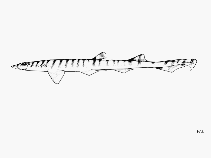http://www.fishbase.org/Summary/speciesSummary.php?genusname=Halaelurus&speciesname=quagga ---> http://192.134.151.83/Summary/speciesSummary.php?genusname=Halaelurus&speciesname=quagga
http://192.134.151.83/Summary/speciesSummary.php?genusname=Halaelurus&speciesname=quagga ---> https://fishbase.mnhn.fr/Summary/speciesSummary.php?genusname=Halaelurus&speciesname=quagga
https://fishbase.mnhn.fr/Summary/speciesSummary.php?genusname=Halaelurus&speciesname=quagga ---> https://fishbase.mnhn.fr/summary/Halaelurus-quagga.html
Halaelurus quagga, Quagga catshark

You can
sponsor
this page
Common name (e.g. trout)
Genus + Species (e.g. Gadus morhua)
-

-
About this page
-
Languages
-
User feedbacks
-
Citation
-
Uploads
-
Related species
-


 Quagga catshark
Upload your
photos
and
videos
Quagga catshark
Upload your
photos
and
videos
Pictures
|
Google image
 Halaelurus quagga
Halaelurus quagga
Picture by
FAO
Elasmobranchii (sharks and rays) >
Carcharhiniformes
(Ground sharks) >
Pentanchidae
(Deepwater catsharks)
Etymology:
Halaelurus:
halos
(Gr.), sea;
ailouros
(Gr.), cat, probably an allusion to the vernacular “catshark,” so named for its cat-like eyes. (
See ETYFish
)
;
quagga:
Etymology not explained, possibly referring to shark’s narrow vertical bars, similar to those of the zebra,
Equus quagga
. (
See ETYFish
)
.
More on author:
Alcock
.
Environment: milieu / climate zone / depth range / distribution range
Ecology
Marine; demersal; depth range 54 - 187 m (Ref.
58018
). Deep-water; 15°N - 8°N, 74°E - 76°E
Western Indian Ocean: Somalia (Indian Ocean coast) and India (Arabian Sea), offshore on continental slope (Ref.
86593
).
Size / Weight / Age
Maturity: L
m
?
range ? - ? cm
Max length : 31.5 cm TL male/unsexed; (Ref.
86593
); 36.8 cm TL (female)
Short description
Morphology
|
Morphometrics
A small shark with numerous (>20) vertical stripes on the body without dark spots, snout tip knoblike but not prominently upturned. Eyes in adults 12–13 times in distance from snout to first dorsal origin. Anterior nasal flaps sub triangular. Gills dorsolaterally placed and elevated above the mouth level. First dorsal-fin origin about opposite pelvic-fin insertion. Light brown above with pale ventral side, dark brown cross bands on the body (Ref.
86593
).
Found on the continental shelves, (Ref.
244
), on or near the bottom (Ref.
30573
). Attains a maximum size of 37.0 cm TL; female of 36.8 cm TL was gravid and contained eight egg cases, four in each uterus (Ref.
86593
). Feeds on shrimps. Collection by deep-sea shrimp trawlers may indicate that the species could have a wider depth distribution, possibly down to 280 m (Ref.
86593
). Not utilized at present (Ref.
244
).
Life cycle and mating behavior
Maturity
|
Reproduction
|
Spawning
|
Eggs
|
Fecundity
|
Larvae
Akhilesh, K.V., K K. Bineesh, C.P.R. Shanis, B.A. Human and U. Ganga
, 2011. Rediscovery and description of the quagga shark,
Halaelurus quagga
(Alcock, 1899) (Chondrichthyes: Scyliorhinidae) from the southwest coast of India. Zootaxa 2781:40-48. (Ref.
86593
)
IUCN Red List Status (Ref.
130435
)
Data deficient (DD)
; Date assessed:
09 February 2017
CITES
Not Evaluated
Not Evaluated
Threat to humans
Harmless
Human uses
Fisheries: of no interest
FAO - Publication:
search
|
FishSource
|
More information
Countries
FAO areas
Ecosystems
Occurrences
Introductions
Stocks
Ecology
Diet
Food items
Food consumption
Ration
Common names
Synonyms
Metabolism
Predators
Ecotoxicology
Reproduction
Maturity
Spawning
Spawning aggregation
Fecundity
Eggs
Egg development
Age/Size
Growth
Length-weight
Length-length
Length-frequencies
Morphometrics
Morphology
Larvae
Larval dynamics
Recruitment
Abundance
BRUVS
References
Aquaculture
Aquaculture profile
Strains
Genetics
Electrophoreses
Heritability
Diseases
Processing
Nutrients
Mass conversion
Collaborators
Pictures
Stamps, Coins Misc.
Sounds
Ciguatera
Speed
Swim. type
Gill area
Otoliths
Brains
Vision
Tools
E-book
|
Field guide
|
Length-frequency wizard
|
Life-history tool
|
Point map
|
Classification Tree
|
Catch-MSY
|
Special reports
Check for Aquarium maintenance
|
Check for Species Fact Sheets
|
Check for Aquaculture Fact Sheets
Download XML
Summary page
|
Point data
|
Common names
|
Photos
Internet sources
AFORO (otoliths) |
Aquatic Commons
|
BHL
|
Cloffa
|
BOLDSystems
|
Websites from users
|
Check FishWatcher
|
CISTI
|
Catalog of Fishes
:
genus
,
species
|
DiscoverLife
|
ECOTOX
| FAO - Publication:
search
|
Faunafri
| Fishipedia |
Fishtrace
| GenBank:
genome
,
nucleotide
| GloBI |
Google Books
|
Google Scholar
|
Google
| IGFA World Record |
MitoFish
|
Otolith Atlas of Taiwan Fishes
|
PubMed
| Reef Life Survey | Socotra Atlas |
Tree of Life
| Wikipedia:
Go
,
Search
| World Records Freshwater Fishing |
Zoological Record
Estimates based on models
Phylogenetic diversity index (Ref.
82804
): PD
50
= 0.5078 [Uniqueness, from 0.5 = low to 2.0 = high].
Bayesian length-weight: a=0.00355 (0.00176 - 0.00714), b=3.09 (2.91 - 3.27), in cm total length, based on LWR estimates for this (Sub)family-body shape (Ref.
93245
).
Trophic level (Ref.
69278
): 4.2 ±0.5 se; based on size and trophs of closest relatives
Resilience (Ref.
120179
): Low, minimum population doubling time 4.5 - 14 years (Fec assumed to be <100).
Fishing Vulnerability (Ref.
59153
): Low to moderate vulnerability (27 of 100).
Back to Search
Random Species
Back to Top
Accessed through:
Not available
FishBase mirror site :
localhost
Page last modified by :
mrius-barile
- 20 July 2016
Fatal error
: Uncaught ArgumentCountError: Too few arguments to function checkEcotox(), 1 passed in /var/www/html/summary/speciessummary.php on line 2304 and exactly 3 expected in /var/www/html/includes/speciessummary.lib.php:2579 Stack trace: #0 /var/www/html/summary/speciessummary.php(2304): checkEcotox() #1 {main} thrown in
/var/www/html/includes/speciessummary.lib.php
on line
2579
|